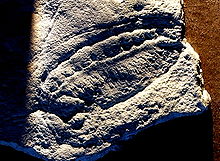
Back Kimberella Bulgarian Kimberella Catalan Kimberella German Kimberella Spanish Kimberella Basque کیمبرلا Persian Kimberella French Kimberella Hungarian Kimberella ID Kimberella quadrata Italian
| Kimberella Temporal range: Ediacaran,
| |
|---|---|

| |
| Remarkably preserved Kimberella at Arkhangelsk Regional Museum, Russia. | |

| |
| Cast of a partial Kimberella fossil. | |
| Scientific classification | |
| Domain: | Eukaryota |
| Kingdom: | Animalia |
| Clade: | Bilateria |
| Genus: | †Kimberella Wade, 1972[1] |
| Type species | |
| †Kimberella quadrata Glaessner & Wade, 1966
| |
| Species | |
| Synonyms | |
Kimberella is an extinct genus of bilaterian known only from rocks of the Ediacaran period. The slug-like organism fed by scratching the microbial surface on which it dwelt in a manner similar to the gastropods,[2] although its affinity with this group is contentious.[3]
Specimens were first found in Australia's Ediacara Hills, but recent research has concentrated on the numerous finds near the White Sea in Russia, which cover an interval of time from 555 to 558 million years ago.[2] As with many fossils from this time, its evolutionary relationships to other organisms are hotly debated. Paleontologists initially classified Kimberella as a type of Cubozoan, but, since 1997, features of its anatomy and its association with scratch marks resembling those made by a radula have been interpreted as signs that it may have been a mollusc. Although some paleontologists dispute its classification as a mollusc, it is generally accepted as being at least a bilaterian.[4]
The classification of Kimberella is important for the scientific understanding of the Cambrian explosion; if it was a mollusc, or at least a protostome, this would mean that the two dominant Nephrozoan lineages would have diverged significantly before 555 million years ago, and if it was at least bilaterian, its age would indicate that animals were diversifying well before the start of the Cambrian.[4]
- ^ Wade, M. (1972). "Hydrozoa and Scyphozoa and other medusoids from the Precambrian Ediacara fauna, South Australia" (PDF). Palaeontology. 15: 197–225. Archived from the original (PDF) on 2011-04-09.
- ^ a b Fedonkin, M.A.; Simonetta, A; Ivantsov, A.Y. (2007), "New data on Kimberella, the Vendian mollusc-like organism (White sea region, Russia): palaeoecological and evolutionary implications", in Vickers-Rich, Patricia; Komarower, Patricia (eds.), The Rise and Fall of the Ediacaran Biota, Special publications, vol. 286, London: Geological Society, pp. 157–179, doi:10.1144/SP286.12, ISBN 978-1-86239-233-5, OCLC 156823511
- ^ Nelson R Cabej (2019). Epigenetic Mechanisms of the Cambrian Explosion. Elsevier Science. p. 152. ISBN 9780128143124.
- ^ a b Cite error: The named reference
Butterfield2006was invoked but never defined (see the help page).